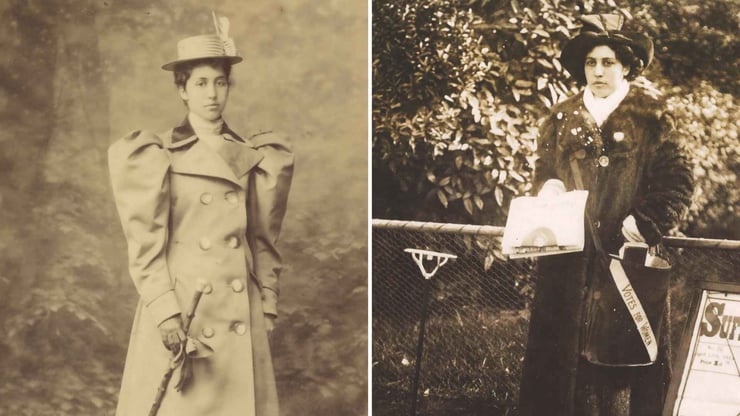Princess Sophia Duleep Singh, ‘A Suffragist'

Princess Sophia Jindan Alexandrovna Duleep Singh, the granddaughter of the great Maharaja Ranjit Singh of Punjab, India, and the goddaughter of Queen Victoria. She was born in England on August 8, 1876 to Maharaja Duleep Singh and Maharani Bamba Muller. The Princess was fifth of six children and grew up in an aristocratic environment at Elveden Hall.
Sophia was not only a princess of high society but also a member of a royal family wealthier than many European monarchies. Despite her royal upbringing, this down to earth Sikh Indian princess dedicated her life to the fight for women’s right to vote in early 20th-century Britain.
Also Read: Remembering the Sikh empire's first Maharaja
She became an active member of the Women’s Social and Political Union (WSPU), an organization founded in 1903 to demand voting rights for women in the UK. At the time, only men had the right to vote, and women had no real say in the laws or decisions that affected their lives. Although the suffrage movement was largely dominated by white British women, Sophia stood out as a woman of color and royal descent passionately advocating for the same cause.
The members of the WSPU came to be known as “The Suffragettes.
In 1908, at the age of thirty-two, Princess Sophia met Una Dugdale, a fellow member of the WSPU. Inspired by their mission, Sophia officially joined the movement in 1909. She quickly rose to prominence and pledged a lifetime commitment to the cause of women’s rights. She regularly attended meetings and soon became part of the inner circle of Emmeline Pankhurst, the movement’s formidable leader.
The same year in October 1909, a new suffragette organization, the Women’s Tax Resistance League, was formed as a forum for nonviolent protest. The suffragettes refused to pay taxes, forcing the government to pay attention to their cause. As an active member of the WSPU, Princess Sophia also refused to pay licenses for her dogs and carriage. Additionally, she declined to pay charges associated with keeping servants, clearly stating that if women could not vote, they should not be expected to pay taxes.
A year later, in 1910, Princess Sophia participated in “Black Friday.” She marched to Parliament Square alongside Emmeline Pankhurst and the Suffragettes to meet the Prime Minister. When the Prime Minister refused to meet them, the protesters refused to leave, leading to hours of brutal clashes between the Suffragettes and the police, during which many women were injured.
During this violence, Princess Sophia sustained several bruises on her arms. She also helped a woman who was being assaulted by an officer, recorded the officer’s badge number, and later filed a formal complaint against him. That day, women were both physically and sexually assaulted, and many were taken to prison. Although Princess Sophia was arrested, she was never imprisoned due to her elevated social status and royal lineage.
The Suffragettes in 1911, also boycotted the census. Princess Sophia, determined to support the cause, refused to pay the census and instead wrote on the census form,
‘No vote, no census, as women do not count, they refuse to be counted, I have a conscientious objection to filling in this form’
She then signed her name underneath in large and bold letters.
As Princess Sophia was part of Britain’s social elite, the authorities were reluctant to act against her. They could not risk arresting a princess and facing the possible consequences. Initially, they politely requested payment of taxes and fines, but over time, their approach grew increasingly forceful. In due time Sophia received letters from the court informing her that she would now face fines and a court hearing.
One morning in 1911, the bailiff from the County of Middlesex arrived at Faraday House with a warrant. They entered the property and seized a seven-stone diamond ring, a piece worth significantly more than the total fines and court costs combined and auctioned it off to recover the unpaid taxes.
In Sophia’s early days Queen Victoria had given her Faraday House, part of the Hampton Court Estate. There, she became an active member of the local WSPU branch in Kingston upon Thames, just a few miles from Hampton Court. In 1913, Sophia attracted further attention from both the press and the government when she sold copies of The Suffragette newspaper right outside the gates of Hampton Court Palace, causing a scandal at the highest levels.
Subsequently, on the morning of 16th January 1914, bailiffs once again forced their way into Faraday House and seized a necklace comprising 131 pearls, along with a diamond and pearl-studded gold bangle featuring a heart-shaped diamond. Regardless of this, in the same year, Princess Sophia donated $51 to the WSPU, the largest individual contribution of that year.
Finally, in 1918, women in Britain who were over the age of 30 and met specific property qualifications were granted the right to vote. Despite this partial win, Sophia started advocating for voting rights for Indian women and supported a public statement demanding that they also be granted the right to vote.
Princess Sophia remained a dedicated advocate for women’s rights until her passing on August 22, 1948, at the age of seventy-one. She had witnessed the historic milestone in 1928, when equal voting rights were granted to all women over the age of 21.
Princess Sophia Duleep Singh’s legacy is one of unwavering courage, conviction, and principle. She did not use her royal status for comfort or personal gain, but as a powerful instrument of change challenging injustice, defying societal expectations, and amplifying the voices of women. Sophia’s lifelong commitment to the cause of women’s rights reminds us that true nobility lies not in titles or heritage, but in the courage to stand up for what is right. Her dedication made her one of the most influential women of her time and a symbol of strength, justice, and reform.
Princess Sophia Jindan Alexandrovna Duleep Singh, the granddaughter of the great Maharaja Ranjit Singh of Punjab, India, and the goddaughter of Queen Victoria. She was born in England on August 8, 1876 to Maharaja Duleep Singh and Maharani Bamba Muller. The Princess was fifth of six children and...
Princess Sophia Jindan Alexandrovna Duleep Singh, the granddaughter of the great Maharaja Ranjit Singh of Punjab, India, and the goddaughter of Queen Victoria. She was born in England on August 8, 1876 to Maharaja Duleep Singh and Maharani Bamba Muller. The Princess was fifth of six children and grew up in an aristocratic environment at Elveden Hall.
Sophia was not only a princess of high society but also a member of a royal family wealthier than many European monarchies. Despite her royal upbringing, this down to earth Sikh Indian princess dedicated her life to the fight for women’s right to vote in early 20th-century Britain.
Also Read: Remembering the Sikh empire's first Maharaja
She became an active member of the Women’s Social and Political Union (WSPU), an organization founded in 1903 to demand voting rights for women in the UK. At the time, only men had the right to vote, and women had no real say in the laws or decisions that affected their lives. Although the suffrage movement was largely dominated by white British women, Sophia stood out as a woman of color and royal descent passionately advocating for the same cause.
The members of the WSPU came to be known as “The Suffragettes.
In 1908, at the age of thirty-two, Princess Sophia met Una Dugdale, a fellow member of the WSPU. Inspired by their mission, Sophia officially joined the movement in 1909. She quickly rose to prominence and pledged a lifetime commitment to the cause of women’s rights. She regularly attended meetings and soon became part of the inner circle of Emmeline Pankhurst, the movement’s formidable leader.
The same year in October 1909, a new suffragette organization, the Women’s Tax Resistance League, was formed as a forum for nonviolent protest. The suffragettes refused to pay taxes, forcing the government to pay attention to their cause. As an active member of the WSPU, Princess Sophia also refused to pay licenses for her dogs and carriage. Additionally, she declined to pay charges associated with keeping servants, clearly stating that if women could not vote, they should not be expected to pay taxes.
A year later, in 1910, Princess Sophia participated in “Black Friday.” She marched to Parliament Square alongside Emmeline Pankhurst and the Suffragettes to meet the Prime Minister. When the Prime Minister refused to meet them, the protesters refused to leave, leading to hours of brutal clashes between the Suffragettes and the police, during which many women were injured.
During this violence, Princess Sophia sustained several bruises on her arms. She also helped a woman who was being assaulted by an officer, recorded the officer’s badge number, and later filed a formal complaint against him. That day, women were both physically and sexually assaulted, and many were taken to prison. Although Princess Sophia was arrested, she was never imprisoned due to her elevated social status and royal lineage.
The Suffragettes in 1911, also boycotted the census. Princess Sophia, determined to support the cause, refused to pay the census and instead wrote on the census form,
‘No vote, no census, as women do not count, they refuse to be counted, I have a conscientious objection to filling in this form’
She then signed her name underneath in large and bold letters.
As Princess Sophia was part of Britain’s social elite, the authorities were reluctant to act against her. They could not risk arresting a princess and facing the possible consequences. Initially, they politely requested payment of taxes and fines, but over time, their approach grew increasingly forceful. In due time Sophia received letters from the court informing her that she would now face fines and a court hearing.
One morning in 1911, the bailiff from the County of Middlesex arrived at Faraday House with a warrant. They entered the property and seized a seven-stone diamond ring, a piece worth significantly more than the total fines and court costs combined and auctioned it off to recover the unpaid taxes.
In Sophia’s early days Queen Victoria had given her Faraday House, part of the Hampton Court Estate. There, she became an active member of the local WSPU branch in Kingston upon Thames, just a few miles from Hampton Court. In 1913, Sophia attracted further attention from both the press and the government when she sold copies of The Suffragette newspaper right outside the gates of Hampton Court Palace, causing a scandal at the highest levels.
Subsequently, on the morning of 16th January 1914, bailiffs once again forced their way into Faraday House and seized a necklace comprising 131 pearls, along with a diamond and pearl-studded gold bangle featuring a heart-shaped diamond. Regardless of this, in the same year, Princess Sophia donated $51 to the WSPU, the largest individual contribution of that year.
Finally, in 1918, women in Britain who were over the age of 30 and met specific property qualifications were granted the right to vote. Despite this partial win, Sophia started advocating for voting rights for Indian women and supported a public statement demanding that they also be granted the right to vote.
Princess Sophia remained a dedicated advocate for women’s rights until her passing on August 22, 1948, at the age of seventy-one. She had witnessed the historic milestone in 1928, when equal voting rights were granted to all women over the age of 21.
Princess Sophia Duleep Singh’s legacy is one of unwavering courage, conviction, and principle. She did not use her royal status for comfort or personal gain, but as a powerful instrument of change challenging injustice, defying societal expectations, and amplifying the voices of women. Sophia’s lifelong commitment to the cause of women’s rights reminds us that true nobility lies not in titles or heritage, but in the courage to stand up for what is right. Her dedication made her one of the most influential women of her time and a symbol of strength, justice, and reform.










Leave a Comment